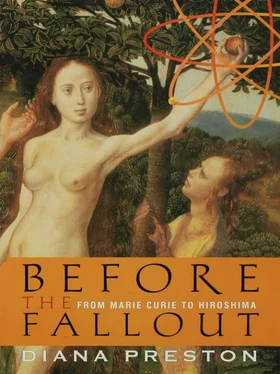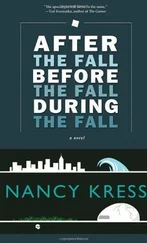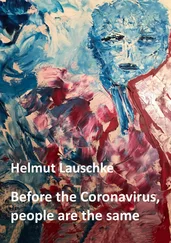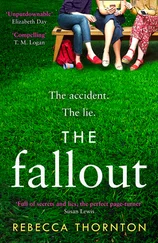Chadwick had arrived in Rutherford’s physics department at the age of eighteen, having won a scholarship to Manchester University. He was from a poor working-class background, shy, and, as he later confessed, “very definitely afraid” of Rutherford, who did not immediately take to the tall, thin, nervous, birdlike young man. However, he was soon convinced of Chadwick’s rare gifts and backed his nomination for an 1 851 Exhibition Science Research Scholarship—the same award that had enabled him to fling down his spade in New Zealand and renounce digging potatoes forever.
Chadwick had arrived in Berlin in 1913 to take up his scholarship working with Hans Geiger. When war came the following year, Chadwick and a German friend were denounced and thrown into prison for, in Chadwick’s words, “having said something we hadn’t said.” Chadwick was held for ten days on a diet of coffee and moldy bread and then released, but not for long. Several weeks later he was rounded up and interned with four thousand others—including “an Earl… musicians, painters, a few race-horse trainers, a few jockeys,” and around one thousand merchant seamen—in an improvised prison camp at the racecourse at Ruhleben, near Spandau. He was barely twenty-three and remembered the experience as the time “when I really began to grow up.”
To preserve his sanity and distract him from the miserable living conditions like rations of kriegswurst —“war sausage made from bread soaked in blood and fat,” from which his digestion would never fully recover—and “the agony when my feet began to thaw out about 11 o’clock in the morning” in unheated stables in the winter, Chadwick gave lectures. He also set up a makeshift physics laboratory in a condemned barracks. Geiger and other German scientists supplied him with bits and pieces of spare equipment. Chadwick also managed guilefully to acquire some radioactive material. Hoping to cash in on the public’s passion for radium, the Berlin Auer company was manufacturing toothpaste containing thorium, promising its customers that it would whiten their teeth and give them a radiant smile. Chadwick used it as a radioactive source in experiments. He also acquired a copy of a new paper by Einstein, published in Germany in November 1915, expanding his work on relativity into a new theory which he called “general relativity.” And so, as Chadwick later described, he became “probably one of the first English people to know about it.” He could not follow the mathematics but found another internee who could explain it to him.
While Chadwick tried to make the best of things, Rutherford’s other star protégé, twenty-seven-year-old Harry Moseley, lost his life. A patriot from a patrician family, he had seen it as his duty to enlist at once. He was killed in hand-to-hand fighting with the Turks on 10 August 1915 in the battle for Gallipoli, where he was serving as brigade signal officer. Rutherford, who had tried hard behind the scenes to have Moseley reassigned to scientific work, wrote sadly that “his services would have been far more useful to his country in one of the numerous fields of scientific enquiry rendered necessary by the war than by exposure to the chances of a Turkish bullet.”
The field “rendered necessary by the war” to which Rutherford turned his own talents was antisubmarine tactics. In early 1915 Germany, in an effort to break the deadlock on the western front, had declared unrestricted submarine warfare, under which, contrary to international law, merchant shipping could be torpedoed on sight, without first being stopped and searched. On 7 May 191£, the German submarine U-20 torpedoed the Cunard passenger liner Lusitania off the coast of Ireland with the loss of 1,200 lives, including 128 citizens of the then neutral United States. The Admiralty realized that Britain needed better ways of locating and destroying U-boats, and Rutherford threw himself with his natural energy into a program for developing underwater listening devices. The result was an early forerunner of sonar, known by the acronym ASDIC (Anti-Submarine Detection Investigation Committee).
Marie Curie also plunged into war work. She scoured laboratories and hospitals for x-ray equipment, solving the problem of how to move it to where it was most needed by converting vehicles into “radiological cars.” French aristocrats put their limousines at her disposal and she equipped twenty vehicles, nicknamed “little Curies.” The x-ray machines themselves were driven by dynamos powered by the car engines. Her own radiological car was a flat-nosed Renault, painted regulation gray with a red cross on the side, in which she dashed from place to place just behind the front lines. She found it distressing work, later writing, “To hate the very idea of war, it ought to be sufficient to see once what I have seen so many times… men and boys… in a mixture of mud and blood.” As the war progressed she was joined by her elder daughter, Irene. Marie also set up two hundred radiological units in field hospitals and trained hundreds of technicians to operate them. Over the course of the war, the units assisted the treatment of more than a million wounded.
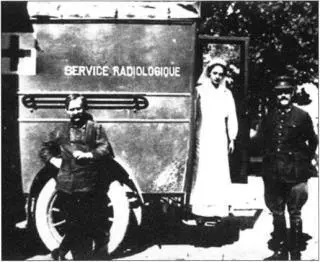
Mobile radiological ambulances known as “little Curies”
First, though, on the instructions of the French government, she had taken steps to protect her precious gram of radium. In the opening weeks of the conflict, when it seemed that the Germans would soon be in Paris, she took the radium, packed into tiny tubes shielded by lead in a case weighing forty-four pounds, by train to Bordeaux, where she deposited it in a bank vault. The following year, 1910, when conditions seemed safer, she retrieved it and began “milking” its radioactive emanation for use in radiotherapy to treat cancers and other diseases.
Elsewhere, science and technology were being applied as never before to the art of war. In November 1911, less than eight years after the first flight by Orville Wright and during his country’s colonial war in Libya, the Italian lieutenant Giulio Gavotti had dropped the first aerial bombs from his flimsy Et-rich monoplane. Less than a month after the sinking of the Lusitania, a German zeppelin had dropped the first bombs on London, bringing home to its inhabitants that neither Britain’s status as an island nor their own as civilians any longer provided protection.
On the evening of 22 April 1915, Germany launched the world’s first poison gas attack, releasing 168 tons of chlorine over the French and Canadian lines on the western front. The German-Jewish chemist Fritz Haber had, from the early stages of the war, been pioneering chemical warfare—the use of poison gases, starting with chlorine—to kill the enemy or to drive them from their trenches. Otto Hahn was summoned to join Haber’s unit, together with fellow scientists such as the physicist James Franck. After discharging gas over Russian trenches, Hahn came across some of the victims. They were lying or crouching “in a pitiable position.” The sight left him “profoundly ashamed and perturbed,” but as the war progressed he and his colleagues became “so numbed that we no longer had any scruples about the whole thing.” As Hahn later recalled, Fritz Haber justified the use of gas by stating, “It was a way of saving countless lives, if it meant that the war could be brought to an end sooner.” Even after the war, Haber argued that the use of gas was “a higher form of killing,” the use of which would be essential in future wars. Haber’s wife, Clara, also a chemist, did not agree. After pleading unsuccessfully with her husband to give up his work, she killed herself in despair the very night in 191£ he returned to the front to prepare for further attacks. Although Britain, France, and the United States initially condemned gas attacks, by the armistice Allied production of chemical weapons outstripped Germany’s.
Читать дальше
